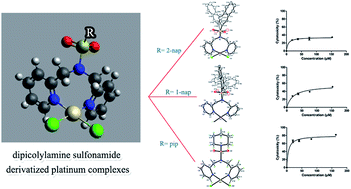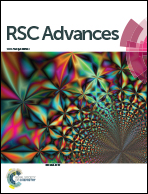Synthesis, characterization and biological evaluation of dipicolylamine sulfonamide derivatized platinum complexes as potential anticancer agents†
Abstract
Three new Pt complexes, [PtCl2(N(SO2(2-nap))dpa)], [PtCl2(N(SO2(1-nap))dpa)] and [PtCl2(N(SO2pip)dpa)], containing a rare 8-membered ring were synthesized in good yield and high purity by utilizing the ligands N(SO2(2-nap))dpa, N(SO2(1-nap))dpa and N(SO2pip)dpa, which contain a dipicolylamine moiety. Structural studies of all three complexes confirmed that the ligands are bound in a bidentate mode via Pt–N(pyridyl) bonds forming a rare 8-membered ring. The intense fluorescence displayed by the ligands is quenched upon coordination to Pt. According to time dependent density functional theory (TDDFT) calculations, the key excitations of N(SO2(2-nap))dpa and [PtCl2(N(SO2(1-nap))dpa)] involve the 2-nap-ligand-centered π → π* excitations. While all six compounds have shown antiproliferative activity against human breast cancer cells (MCF-7), the N(SO2pip)dpa and N(SO2(2-nap))dpa ligands and [PtCl2((NSO2pip)dpa)] complex have shown significantly high cytotoxicity, directing them to be further investigated as potential anti-cancer drug leads.



 Please wait while we load your content...
Please wait while we load your content...